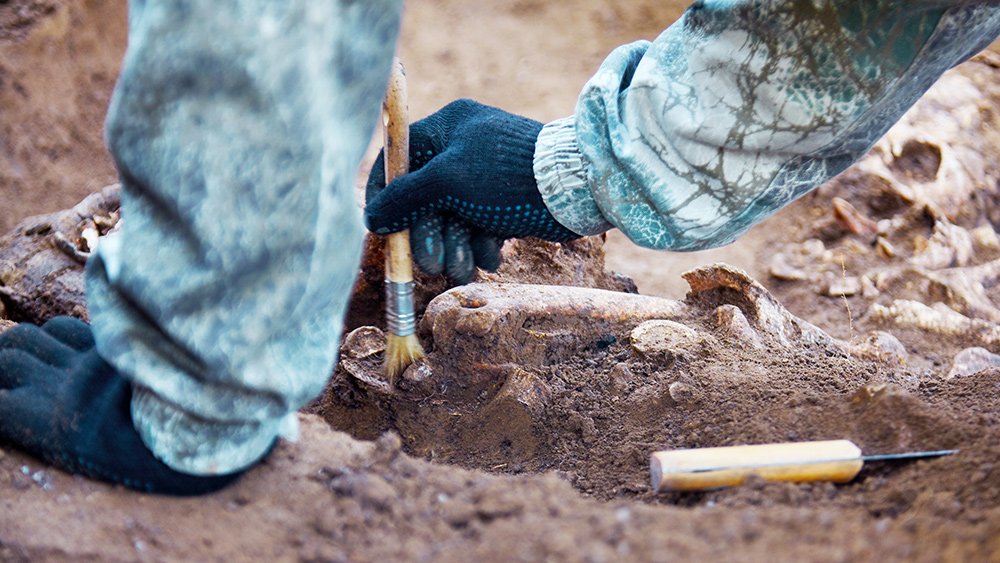Archaeologists discover 5,000-year-old tavern in southern Iraq’s Lagash site
02/08/2023 / By Kevin Hughes

Archaeologists discovered a surprisingly huge “tavern” complete with benches, a clay oven, storage vessels and a clay refrigerator known as a “zeer” at the archaeological site of Lagash in southern Iraq.
Holly Pittman, director of the Lagash dig project, teamed up with colleagues from the University of Pennsylvania (UPenn) and University of Pisa in Italy for a fourth expedition to the site last fall. Using high-tech tools, the team accurately located trenches and proceeded to unearth ceramic figures and another kiln.
The archaeologists used drone photography and thermal imaging; magnetometry, which captures the magnetic intensity of buried articles; and microstratigraphic sampling, a clinically precise type of excavation. They also removed sediment cores that show millennia of ecological development to understand the city’s environmental background.
Expeditions at Lagash had begun back in 2019, but took a pause due to the pandemic. But the discovery of the ancient tavern gives another look into the lives of common people who lived some 5,000 years ago in this part of the world, a location Penn researchers have studied since the 1930s. (Related: Innate ingenuity: Ethiopian dig unearths ancient stone tools, some of the oldest ever discovered at more than 2.58 million years old.)
Ancient tavern provides a glimpse of life at Lagash
“It’s a public eating space dating to somewhere around 2700 BCE. It’s partially open air, partially kitchen area,” Pittman said.
“At more than 450 hectares, Lagash was one of the largest sites in southern Iraq during the third millennium. The site was of major political, economic and religious importance. However, we also think that Lagash was a significant population center that had ready access to fertile land and people dedicated to intensive craft production.”
The UPenn professor compared Lagash to the city of Trenton in New Jersey, once known as the East Coast’s center of manufacturing.
Around 6,000 years ago, the mouth of the Persian Gulf lay some 150 miles farther northwest. Close to that ancient shoreline, a trio of settlements – Girsu, Lagash, and Ni?in – comprised the bigger city-state called Lagash. The three cities were united as a single powerful and wealthy political body for more than 150 years.
Archaeologists originally thought that the site of Girsu was Lagash. But in 1953, a surface inscription showed the ancient city’s real location was at a place called Tell al-Hiba, named after the neighboring village.
In the 1960s and 1970s, a team headed by Donald Hansen of New York University‘s Institute of Fine Arts and Vaughn Crawford of the Metropolitan Museum of Art completed five field seasons in the ancient city concentrating on monumental and administrative architecture.
The Iran-Iraq War halted that work and, save for a University of California Los Angeles survey in 1984, the site remained untouched until 1990 – when Hansen and colleagues returned. That 1990 team included Pittman, a former student of Hansen.
“Donald and I walked around the site and fantasized that we would start a new campaign, and it would be NYU and Penn and we would go together,” she recalled.
However, the First Gulf War stopped the research. Although Pittman kept working in the Middle East over the next few decades, it wasn’t until 2017 that she approached the State Board of Antiquities and Heritage in Iraq for a permit to continue working at the site.
Discoveries.news has more about the latest archaeological finds.
Watch this video that discusses the ruins of the Sumerian civilization that lie buried in Iraq.
This video is from the Truther Network channel on Brighteon.com.
More related stories:
Archaeologists discover ruins of Mayan civilization in Guatemala using LiDAR technology.
Buried treasure: Gold and precious gems uncovered from a 5th century burial site in Czech Republic.
Ancient human remains unearthed in Ethiopia older than previously thought, reveals study.
Sources include:
Submit a correction >>
Tagged Under:
ancient civilization, ancient history, ancient tavern, Archaeology, artifacts, breakthrough, city-state, culture, discoveries, Donald Hansen, Girsu, history, Holly Pittman, Iraq, Lagash
This article may contain statements that reflect the opinion of the author
RECENT NEWS & ARTICLES
COPYRIGHT © 2017 REAL SCIENCE NEWS





















